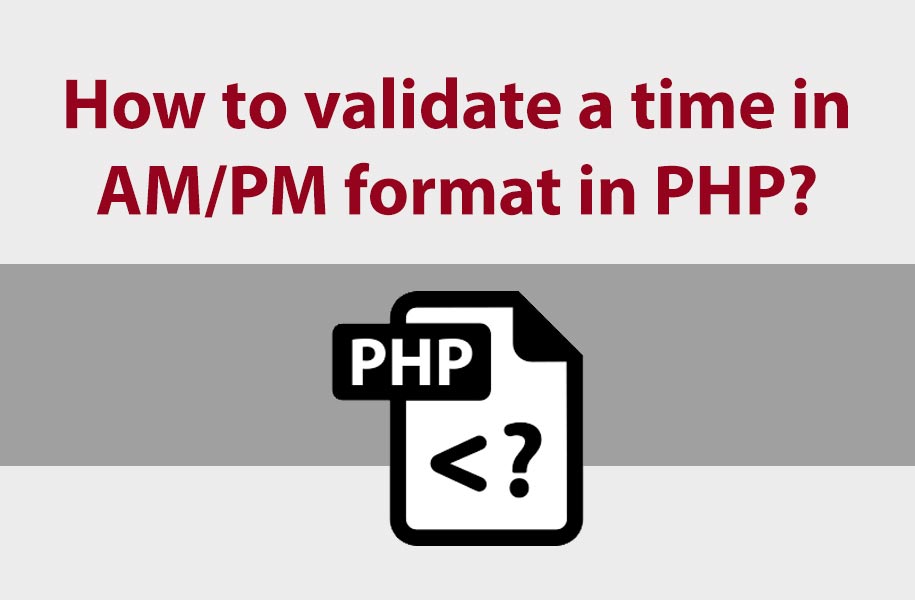PHP
How to validate a time in AM/PM format in PHP?

How to validate a time in AM/PM format in PHP?
Validate time in AM/PM format in PHP
Mastering Time Validation in AM/PM Format with PHP
In PHP programming, ensuring the accuracy and validity of time inputs in the AM/PM format is crucial for various applications. Whether you’re building a scheduling system, event management tool, or time-sensitive application, validating time entries helps maintain data integrity and a seamless user experience.
In this article, we will explore the techniques and best practices for validating time in the AM/PM format using PHP.
- Understanding the AM/PM Format:
The AM/PM format represents time using a 12-hour clock, where AM stands for “ante meridiem” (before noon) and PM stands for “post meridiem” (afternoon and evening). It is essential to comprehend this format’s structure and constraints for effective validation. - Parsing and Formatting Time:
To validate time in the AM/PM format, you can use PHP’s built-in functions, such asstrtotime()anddate(), to parse and format time strings. These functions allow you to convert time inputs into a standardized format for further validation. - Regular Expression Validation:
Utilize regular expressions to validate the correctness of the time input. Construct a regular expression pattern that matches the AM/PM format and apply it to the user’s input. This technique ensures that the time follows the expected structure and meets the required criteria. - Range and Boundary Validation:
In addition to format validation, consider implementing range and boundary checks to validate the time’s hours, minutes, and seconds. Ensure that the time falls within appropriate limits (e.g., hours between 1 and 12, minutes between 0 and 59) and handle potential edge cases gracefully. - Handling Timezone Considerations:
When working with time inputs, it’s crucial to consider timezones. Validate whether the user’s input includes timezone information or implement logic to convert the time to a specific timezone for consistent handling across the application. - Providing Clear Error Messages:
To enhance the user experience, provide meaningful error messages when time validation fails. Inform users about the specific validation criteria they didn’t meet (e.g., incorrect format, out-of-range values), allowing them to correct their input promptly. - Testing and Edge Cases:
Thoroughly test your time validation code to ensure its reliability. Consider edge cases such as midnight (12:00 AM) and noon (12:00 PM) to handle potential ambiguities correctly.
Conclusion: AM/PM time validation in PHP
Validating time in the AM/PM format is essential for maintaining data integrity and delivering a seamless user experience in PHP applications.
By following the techniques discussed in this article—such as parsing and formatting time, utilizing regular expressions, and implementing range validation—you can ensure that time inputs conform to the expected format and meet the required criteria.
Remember to handle timezone considerations, provide clear error messages, and thoroughly test your validation code to achieve robust and accurate time validation.
With these skills in your toolkit, you can master the art of validating time in the AM/PM format with PHP, empowering your applications with accurate and reliable time handling capabilities.
Example PHP code: PHP time validation in AM/PM format
Certainly! Here’s an example PHP code snippet that demonstrates how to validate a time in AM/PM format:
<?php
// Function to validate time in AM/PM format
function validateTime($time) {
// Define the regular expression pattern for AM/PM format
$pattern = '/^(0?[1-9]|1[0-2]):[0-5][0-9]\s[APap][mM]$/';
// Perform the validation using the pattern
if (preg_match($pattern, $time)) {
return true; // Time is valid
} else {
return false; // Time is invalid
}
}
// Example usage
$time1 = '10:30 am';
$time2 = '5:45 PM';
$time3 = '13:00 pm';
if (validateTime($time1)) {
echo "$time1 is a valid time.";
} else {
echo "$time1 is an invalid time.";
}
echo "<br>";
if (validateTime($time2)) {
echo "$time2 is a valid time.";
} else {
echo "$time2 is an invalid time.";
}
echo "<br>";
if (validateTime($time3)) {
echo "$time3 is a valid time.";
} else {
echo "$time3 is an invalid time.";
}
?>In this example, the validateTime() function takes a time string as input and uses a regular expression pattern (/^(0?[1-9]|1[0-2]):[0-5][0-9]\s[APap][mM]$/) to perform the validation. The pattern ensures that the time follows the AM/PM format, where hours are between 1 and 12, minutes are between 00 and 59, and the AM/PM indicator is case-insensitive.
The code then demonstrates the usage of the validateTime() function by validating three example time strings ($time1, $time2, $time3) and displaying the corresponding validation results.
Feel free to customize this code according to your specific requirements and use it to validate time inputs in the AM/PM format in your PHP applications.
Related searches: How to validate a time in AM/PM format in PHP?
validate time in AM/PM format in PHP, PHP time validation in AM/PM format, AM/PM time validation in PHP, validate time string in PHP, PHP time validation regex, PHP validate time format, validate time input in PHP, PHP time validation function, PHP time validation example, time validation in PHP programming, PHP time validation best practices, PHP time validation techniques, PHP AM/PM time validation, PHP time validation for programmers, PHP time validation for developers, PHP time validation SEO optimization, PHP time validation worldwide programmers, PHP time validation expert tips, PHP time validation professional techniques, PHP time validation unique content, PHP time validation best SEO practices, PHP time validation global audience, PHP time validation for coding enthusiasts, PHP time validation creative applications


